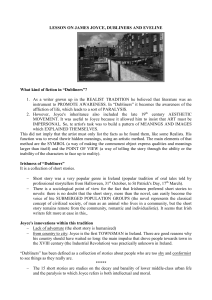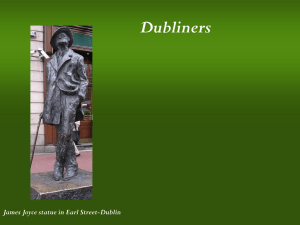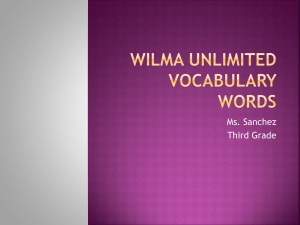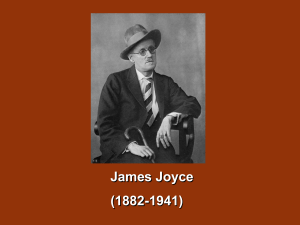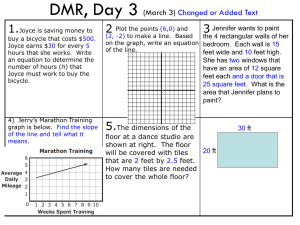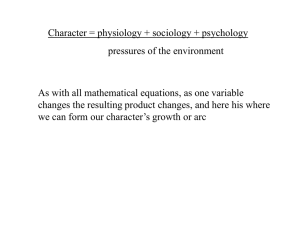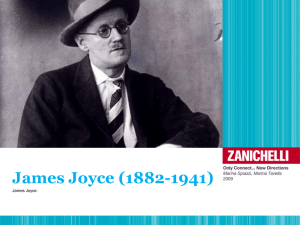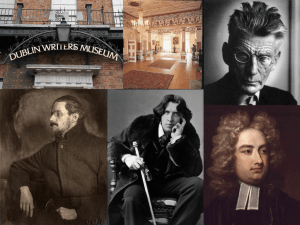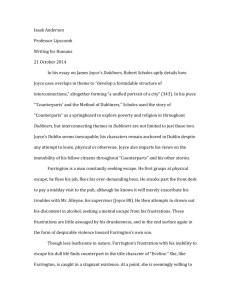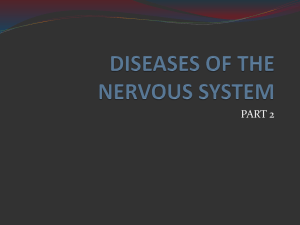Final Paper - Michigan State University
advertisement
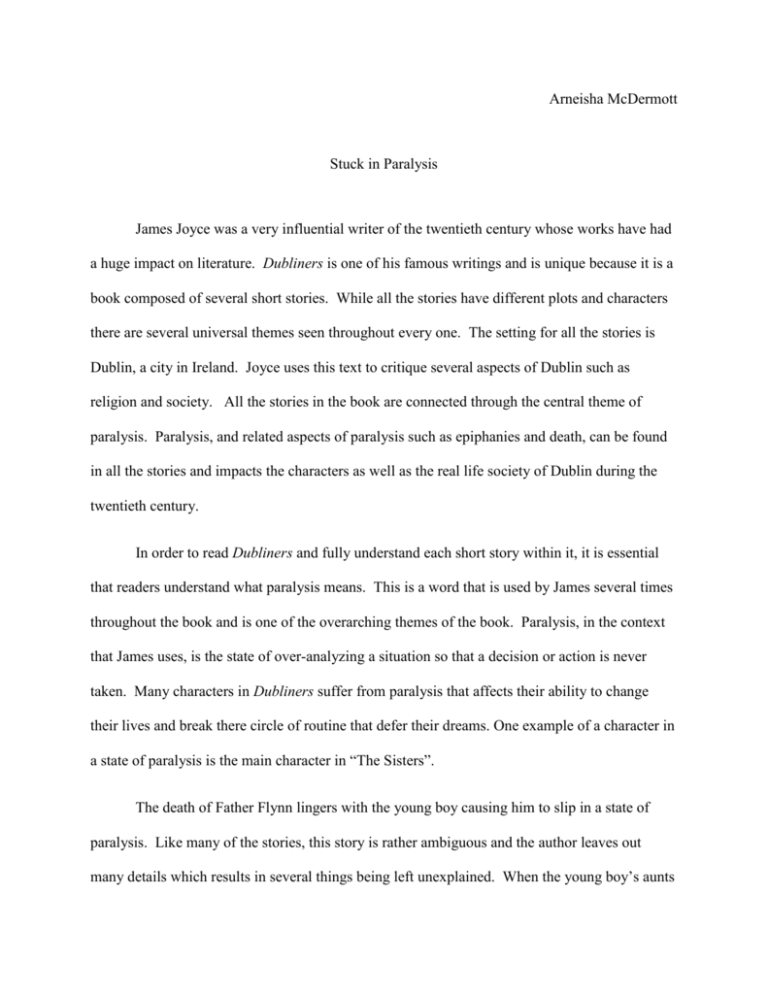
Arneisha McDermott Stuck in Paralysis James Joyce was a very influential writer of the twentieth century whose works have had a huge impact on literature. Dubliners is one of his famous writings and is unique because it is a book composed of several short stories. While all the stories have different plots and characters there are several universal themes seen throughout every one. The setting for all the stories is Dublin, a city in Ireland. Joyce uses this text to critique several aspects of Dublin such as religion and society. All the stories in the book are connected through the central theme of paralysis. Paralysis, and related aspects of paralysis such as epiphanies and death, can be found in all the stories and impacts the characters as well as the real life society of Dublin during the twentieth century. In order to read Dubliners and fully understand each short story within it, it is essential that readers understand what paralysis means. This is a word that is used by James several times throughout the book and is one of the overarching themes of the book. Paralysis, in the context that James uses, is the state of over-analyzing a situation so that a decision or action is never taken. Many characters in Dubliners suffer from paralysis that affects their ability to change their lives and break there circle of routine that defer their dreams. One example of a character in a state of paralysis is the main character in “The Sisters”. The death of Father Flynn lingers with the young boy causing him to slip in a state of paralysis. Like many of the stories, this story is rather ambiguous and the author leaves out many details which results in several things being left unexplained. When the young boy’s aunts and uncles give their accounts of Father Flynn, a different picture is painted in our heads than when the young boy describes him. We see that there was a relationship between them that the adults felt was very odd. The more the boy thinks about Father Flynn, the more he realizes that indeed there was something awkward about him. His overthinking ultimately leads him into not being able to speak when he and his aunt visit the sisters. This story is important because it is Joyce’s critic on society and religion. The narrator suggests that Father Flynn himself died of paralysis. The city is plagued with the strict tedious routines of religion that controls the city and its people. We see another critic on religion in the next story in Dubliners called “An Encounter”. There are references to the tensions between Catholic and Protestant religions in this story when Father Butler scolds the young boys for reading cowboy and Indian stories. He says that Catholic boys do not read stories like that, only Protestants. This is an example of how one religion is placed as the more superior religion and they is a certain way one should live their life in order to be faithful to their religion. In “An Encounter”, the readers can also recognize the theme of paralysis within the characters. The characters in this story yearn for an escape outside of their boring routine ridden lives. They seek new adventures and when they try to leave their routines behind they end up turning their back on their new adventure instead. Young school boys in the story skip school one day to go on an adventure n effort to create excitement in their life. This is a concept that James writes about often and can be seen as a critic of the society he lived in. Many of the characters in the stories often lose their selves or remain in isolation for the rest of their lives because they never change their circle of routine. They often miss out on new opportunities, love or fulfilling their dreams because they are paralyzed with the overthinking they do. This is no exception for the boys in “An Encounter”. The day they skip school to seek a more adventurous day, they head into Dublin to visit “The Pigeon House”. Their day is going well until they are confronted with a weird old man. He engages in a conversation with the boys that gives him creepy presences amongst the boys. He asks them are they have any “sweethearts” and talks about what he likes about girls. Right away the boys feel uneasy and even give out fake names in order to protect their identity when talking to the man. The conversation becomes even more odd when he tells Mahony that he fantasizes being able to whip him. The narrator of the story is in a state of paralysis as a result of the conversation with the man. His speech is literally paralyzed and he does not know what to make of the conversation. This shows that going to Dublin and meeting the stranger was a disruption of routine in a negative way and caused the narrator to yearn for his old routine again. This one encounter ruined the narrators want for change in his life. He realized that maybe it is best for him to keep his life the same. This is James’ way of telling the readers that we will encounter situations that make us uncomfortable but every situation should not affect our decisions for change in our lives. This is something that many characters face in the book. They all have desires but they do not pursue their desires because of the fear disrupting routine brings. James Joyce’s writing embodies this overarching theme of paralysis and can be seen in the story “Eveline”. This story really illustrates the negative aspects of holding onto the past and how holding onto the past stops you from enjoying your future. The main character Eveline is faced with a dilemma to either stay at home and be an obedient daughter, or leave and get married to the man she loves, Frank. She secretly agrees to marry him and live in Buenos Aires but she feels uneasy about her decision. Throughout the story she reflects on her life and begins thinking about what decision would be best. Her father is abusive and living a domestic life like her mother did does not sound anything but sad and uneventful. She yearns for an escape from the boring life she feels is her destiny but when the moment arrives for her to get on the boat with Frank and move toward a better life, she is unsurprisingly motionless from paralysis. This is another example of how Joyce is critiquing his home town’s values and traditions. Many women of his century became trapped within a domestic life and never got to experience life to the fullest. Eveline’s life is determined by her daily routine like the other characters. Routine overrides any of her desires and in the act of over analyzing the situation she makes no decision at all leaving her a victim to paralysis like everyone else. Like the others she has an epiphany and realizes that the life she currently lives in undesirable and she must make a change if she wants something different for her life. But the routine is too powerful as it is for the other characters. All the characters have some sort of desire for an escape out of their predictable lives, but are trapped within the circle of routine. Paralysis traps them and prevents them from experiencing new things and happiness. How is it that all the characters realize this but are too afraid to be in control of their own happiness? This is something that Joyce must have felt that the real life people of Dublin in his time suffered from. One thing that Joyce felt is that in order for one to be successful they must leave Dublin. Perhaps he wanted to be a demonstration of that himself because he left the country after a selfimposed exile. This is interesting because some of the characters in his book long for getting out of Dublin as well. For example Little Chandler in “A Little Cloud” has a desire to travel outside of the country to pursue his writing dreams. Another example is how Eveline considers running off to marry Frank and move to Buenos Aires. Moving away from Dublin symbolizes freedom, a fresh start and happiness. While all of the stories have a rather somber, negative tone, Joyce displays the hope and confidence he has in his society of Dublin to change their conservative traditional ways of life. After reading each story closely, it is apparent that Joyce has faith in the Irish people he had been critiquing throughout Dubliners. He believes that it is possible for individuals to change and we see that this change did not happen in 1910 like Woolf argues. Even though the characters in Joyce’s book do not break the cycle of paralysis and do what they aspire to do in their dreams, Joyce carefully gives each character epiphanies. This reoccurring idea of the characters coming to sudden realizations about their lives, even though they fail to change, shows that Joyce has faith in the Irish people as a whole being able to get rid of the paralysis they are stuck in. While reading Dubliners I noticed that not only was paralysis a major theme throughout the book, but also this idea of death. There were several instances of death for example in “The Sisters” the death of Father Flynn, the death of Mrs. Sinico is “A Painful Case” and reminiscing loved ones who have passed away in “The Dead”. It is interesting and no coincidence that the book beginnings with a story about death and ends with a story about death. There is a reason the author chose to embed the rest of the short stories in between two stories about death. It is a way to foreshadow the deaths that occur in the other stories as well as a way to serve as a symbol for paralysis. Paralysis or this idea of over analyzing a situation resulting in no decision being made and no change is death within itself. The characters that are affected by paralysis are still alive, literally speaking, but they are actually dead. Their lives are dark and miserable. They are alive but they might as well be dead. Paralysis has taken over their lives and affected the decisions they make leaving their lives uneventful and depressing. In some cases paralysis actually drives people to death like in “A Painful Case”. The characters in the book all appear to be different but they are similar and connected when looked through a perspective focused on paralysis. This is reveals something about the society Joyce lived in and I believe that was his sole purpose of writing Dubliners. Like many of his other novels, he wanted to paint a clear picture of Dublin for the people outside of Dublin or unfamiliar with it. His books show us as readers what problems existed in society and how destructive they were and still can be today. Joyce shares with us his thoughts and critiques on society and the individuals from all different perspective but with the same plague. We are introduced to children, men, and women of all ages. Like I stated before, the characters all look different but the unchanging, uneventful routine ridden lives they live are the same. This symbolizes how not only one individual in society is affected by paralysis. If only one person out of a society was affected it would not make much of a difference and Joyce would probably not even care. However since every character in his book is affected by it, this is a problem that is worthy of attention since it affects everyone. He is stressing the point that something is going on in the Irish society that needs to be changed. After reading the Dubliners we see that the characters in the book are all stuck in a city of paralysis.
